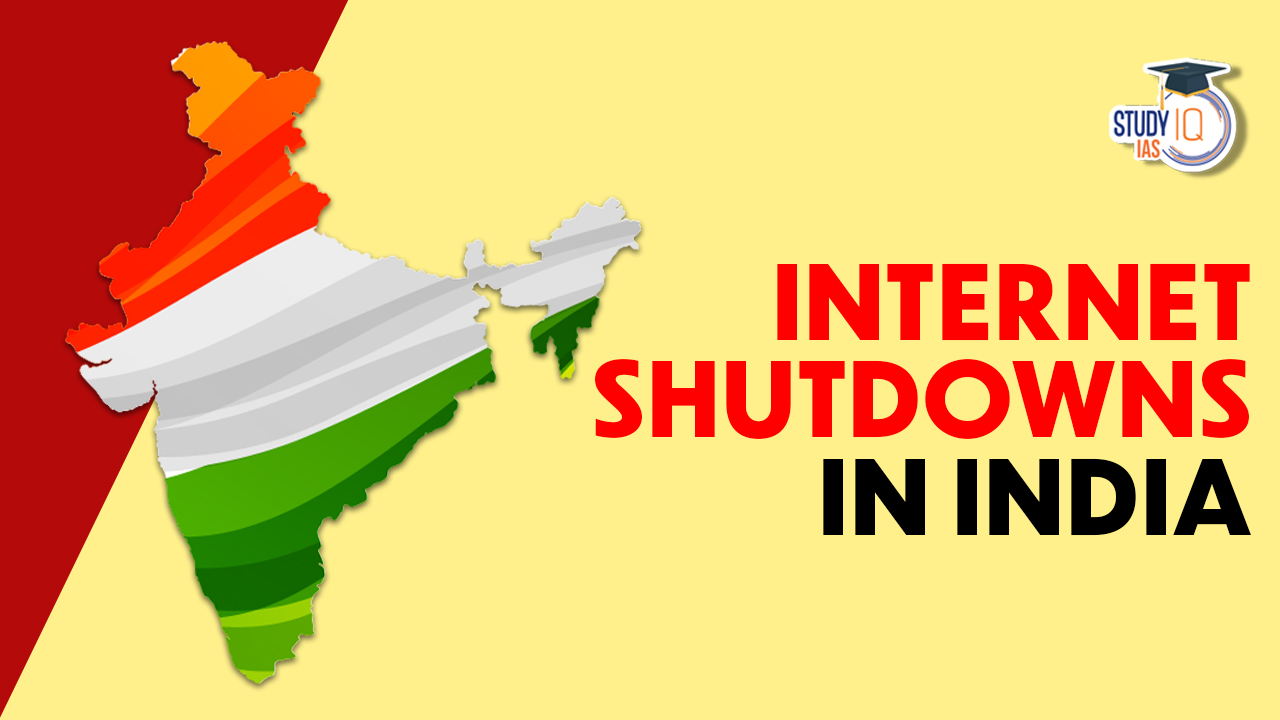Table of Contents
Context: According to the data from global tracker Top10VPN, the total value of internet shutdowns in India has touched $255.2 million in 2023.
Background
- The rise of internet from ‘luxury’ to ‘need’: The 21st century is the age of technology. We have significant technological advancements, with the internet being one of them. Initially, it was just a ‘luxury’ but now it has become a ‘need’. One cannot imagine an ‘internetless’ life.
- India becoming the capital of internet shutdowns: Internet shutdowns have become common in India nowadays. When Article 370 of the Indian Constitution was abrogated, it was the internet that was first shut down. The fear of violence and upheavals was in the backdrop of the government’s mind when the internet was shut down in Jammu and Kashmir.
What is Internet Shutdown?
- Internet shutdown is defined as an intentional disruption of the internet services in a particular area.
- It can be implemented in different ways, including blocking access to specific websites or platforms, throttling or slowing down internet speeds, or completely cutting off internet connectivity.
- It can be temporary, lasting for a few hours or days, or they can be prolonged, lasting for weeks or even months.
Key trends on ‘Internet Shutdowns in India’
- According to a report by Access Now and the KeepItOn coalition, India enforced as many as 84 internet shutdowns in 2022 and was on top of the list for the fifth year in a row.
- Jammu and Kashmir accounted for the highest number of internet shutdowns followed by Rajasthan and West Bengal.
- According to the Access Now report, India witnessed 109 internet shutdowns in the year 2020 against the 155 lockdowns all over the world.
- Instances of major internet shutdowns in India
- Jammu and Kashmir witnessed the longest internet shutdown which started in 2019 with the abrogation of Article 370 was finally lifted after a long gap of 18 months in February 2021.
- The Manipur government banned internet to maintain law and order after ethnic violence broke out in the state. It has been more than 40 days since the internet was shut down in the state.

Legality of Internet Shutdowns in India
- Section 144 of CrPC: Till the year 2017, internet shutdowns were imposed largely under Section 144 of the Code of Criminal Procedure (CrPC).
- Section 144 of CrPC gave the police and the District Magistrate the powers in order to prevent unlawful gathering of people and also to direct any person to abstain from a certain activity.
- However, in 2017, the Government promulgated the Temporary Suspension of Telecom Services (Public Emergency or Public Safety) Rules 2017.
- 2017 Rules provide for a temporary shutdown of telecom services in a region on grounds of public emergency (up to 15 days at once).
- Such directions can be issued by Secretary to the Government of India in the Ministry of Home Affairs in the case of Government of India or by the Secretary to the State Government in-charge of the Home Department in the case of a State Government.
Reasons behind Internet Shutdowns
- National security concerns: Governments may justify that shutting down the internet or specific communication channels is necessary to prevent the coordination of illegal activities, terrorist threats, or to maintain public safety during sensitive periods.
- Political control and suppression: During periods of political unrest, or protests, authorities may restrict access to prevent the spread of information, curb organization efforts, or silence dissent.
- Curbing the spread of misinformation: Governments may enforce internet shutdowns to control the flow of information and combat the dissemination of false or misleading content.
- Preserving national unity or stability: Internet shutdowns may be employed in regions with secessionist movements or conflicts to maintain national unity or stability.
- Preventing exam cheating: Some countries have implemented internet shutdowns during national examinations to prevent cheating and ensure the integrity of the testing process.
Various Techniques Used to Shut Down the Internet
- DNS Tampering: By tampering with Domain Name System (DNS), authorities can redirect or block access to specific websites or services. This can be achieved by altering DNS records, redirecting DNS queries to different IP addresses, or blocking access to certain DNS servers altogether.
- IP blocking: IP blocking is a technique where specific IP addresses are targeted for blocking. Authorities can maintain a blacklist of IP addresses associated with particular websites, platforms, or services, and instruct network infrastructure to deny access to those addresses.
- URL filtering: It involves selectively blocking or allowing access to specific URLs (web addresses). Authorities can employ filtering systems or firewalls that examine the requested URLs and decide whether to allow or block access based on predefined criteria.
- Content filtering and keyword blocking: Governments can employ advanced filtering systems to monitor and block specific keywords, phrases, or content that they deem sensitive or threatening.
- Throttling or slowing down internet speeds: It involves deliberately slowing down internet speeds to the extent that it becomes impractical or impossible to access certain websites or services.
Impacts of Internet Shutdowns
- Economic impact: Data from global tracker Top10VPN shows that India suffered a loss of $ 255.2 million due to internet shutdowns, while in 2022, the country suffered a loss of $ 184.3 million.
- Disruption of communication: Internet shutdowns disrupt communication channels, making it difficult for individuals to connect with their loved ones, and access emergency services.
- Limitations on education and research: Internet shutdowns hinder access to online educational resources, e-learning platforms, and research materials.
- Impediment to healthcare services: The internet plays a crucial role in healthcare delivery, including telemedicine, remote consultations, and the access to medical information.
- Impact on fundamental rights: The fundamental rights to speech, conduct business, access to healthcare, express dissent, and movement of people in a state, are compromised.
- Impact on journalism: An internet shutdown can hamper the reach of the on-ground-reporting and cause underreporting of local issues.
- Risk to privacy: For example, when people turn to untrustworthy VPNs in order to route around restrictions, their personal data is at risk.
- Disrupts political transparency: Internet shutdowns undermine or eliminate access to digital tools that are critical for campaigning, promoting public discussion, conducting voting, and overseeing the electoral process.
Way Forward
- Parliamentary panel recommendations on internet shutdowns: The Standing Committee on Communications and Information Technology report on “Suspension of Telecom Services and Internet and its impact” has recommended-
- Asked the DoT to lay down a clear-cut principle of proportionality and procedure for lifting of shutdown in coordination with the home ministry.
- Rejected the logic of the DoT and MHA for not maintaining the record of the shutdown, saying it cannot simply take the plea that police and public order are essentially state subjects.
- A centralized database of all internet shutdowns by the states can be maintained either by DoT or MHA.
- DoT should expand the review committees that review the order of telecom services suspension under the Telecom Suspension Rules, 2017.
- A study should be commissioned by the government of India to assess the impact of the internet shutdown on the economy.
- UN Principles: The UN Human Rights Office provides that six principles should be followed by imposing internet shutdown.
- Clearly grounded in unambiguous, publicly available law.
- Necessary to achieve a legitimate aim.
- Proportional to the legitimate aim and the least intrusive means to achieving that end.
- Subject to prior authorization by a court or another independent adjudicatory body.
- Communicated in advance to the public and telecommunications or Internet service providers.
- Subject to meaningful redress mechanisms accessible to those whose rights have been affected by the shutdowns.


 Phone-tapping in India, Legal Framework ...
Phone-tapping in India, Legal Framework ...
 Bihar Assembly Election 2025 Dates, Poli...
Bihar Assembly Election 2025 Dates, Poli...
 Jharkhand High Court Assistants Admit Ca...
Jharkhand High Court Assistants Admit Ca...





















